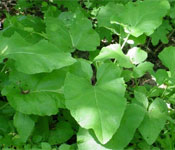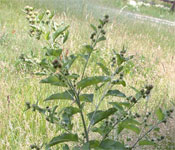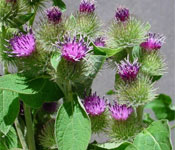Family – Sunflower Asteraceae
Life Cycle – Biennial
Habitat – forage crops, hay fields, rangeland, irrigation, roadsides, waste areas
Key Features
- Thick, fleshy tap root
- Large, heart-shaped basal leaves
- Receptacle with narrow, hooked bristles forming a bur
Seedling
Cotyledons are oval and have noticeable veins. The first true leaves are petioled and ovate with entire to slightly wavy margins. The surface of the leaves is somewhat hairy and wrinkled.
Juvenile
Burdock develops a thick, fleshy tap root and large basal rosette in the first year. The rosette leaves are ovate to triangular with a heart-shaped base and a wavy margin. Common burdock leaves are often very large an dresemble rhubarb except that the undersides are wooly-hairy and the petioles are hollow. Stems are erect and often much-branched. They are rough-hairy, hollow and grooved lengthwise. Stem leaves are usually much smaller and less heart-shaped than the rosette leaves.
Mature
Heads are almost round and are found either singly or in clusters at the ends of branches. Each head has purple disk flowers surrounded by a receptable with involucral bracts modified into narrow, hooked bristles. This structure forms the bur that aids in the dispersal of common burdock seeds by animals and man. The seeds found within th ebur are oblong, smooth and mottled. They look somewhat like narrow, curved sunflower seeds.
 |
 |
 |
